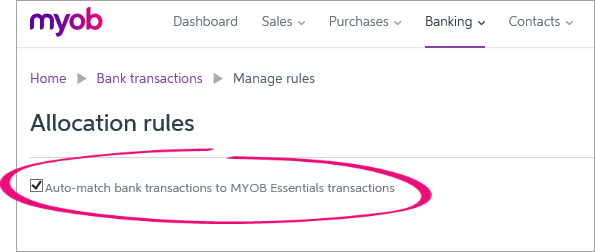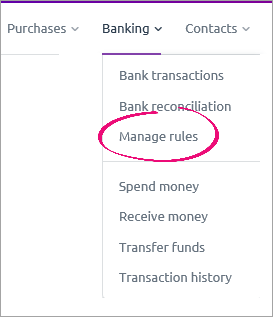The Allocation rules page lets you manage the way MYOB Essentials automatically handles your bank transactions. You can choose whether to allow MYOB Essentials to automatically match your transactions, and you can set up rules to automatically allocate the transactions that appear on your bank feed. Transactions that are auto-matched or automatically You use rules in MYOB Essentials to automatically match or allocate transactions that come in via bank feeds or imported bank statements. Once you've created a rule, you can edit or delete it. Transactions that are automatically matched or allocated based on your rules will appear in the Bank transactions page with a magic wand  Image Added icon next to them. Image Added icon next to them.  Image Removed Image Removed Image Added Image Added
If a match or allocation is wrong, you can unmatch or unallocate the transaction. See Allocating bank transactions and Matching bank transactions. Auto-matchingBy default, MYOB Essentials will auto-match a transaction if there's one exact match available. You might want to turn this off if you've got a lot of transactions for the same amount, or if you find transactions are often incorrectly auto-matched. If you don't want transactions to be auto-matched, you can deselect the Auto-match bank transactions to MYOB Essentials transactions option from the Allocation rules page.  Image Removed Image Removed Image Added Image Added
If auto-matching is turned off, transactions with one match will show on the Bank transactions page as having 1 match available and you'll need to manually confirm the match yourself. See Matching bank transactions. Allocation rulesIf you regularly receive certain transactions, you can set up an allocation rule. MYOB Essentials will use these rules to allocate the amounts of all imported bank transactions that meet the criteria to the nominated MYOB Essentials account. You can set up a rule using any unique text in the bank transactions you import into MYOB Essentials. When the same type of transaction always uses the same text, you can use that text to automatically allocate the transaction to the correct MYOB Essentials account. Banks provide only brief descriptions for transactions, but they usually contain enough information to identify the relevant MYOB Essentials account. Allocation rules won’t cover all transactions, but they save significant time once you’ve set them up. They will apply every time you import new bank transactions, but you can edit or delete them at any time. Make sure the description text is suitableTo make sure the description text of a bank transaction is suitable to be used as an allocation rule, check that: - the same text appears regularly in transactions,
- the text is unique, and
- if the text is long, it can be shortened easily and still refer to all items belonging to a certain account.
Editing and deleting allocation rulesTo edit and delete allocation rules, access the Allocation rules page by clicking the Banking menu, then click Manage rules.  Image Added Image Added
| UI Expand |
|---|
| title | To create edit allocation rules |
|---|
| To edit allocation rulesComplete the fields at the top of the Create Allocation Rule window.In the first field, enter the text that you want to use to allocate transactions.
Note that if you’re creating an allocation rule while you’re allocating a transaction to a MYOB Essentials account, this field will contain the transaction’s Description text. If necessary, edit the text. | UI Text Box |
|---|
| You can only access the Allocation Rules window if you’ve imported bank transactions and haven’t yet reconciled them. |
Click Banking. The Bank transactions page appears.You can create allocation rules in two ways. | To… | Do this… |
|---|
| create allocation rules from the AllocationRules page | - Click the Manage allocation rules link at the top of the page. The AllocationRules page appears, displaying details of all existing allocation rules in the list.
- Click Create allocation rule. The Create Allocation Rule window appears.
| | create allocation rules while you’re allocating a bank transaction to a MYOB Essentials account | - Find an unreconciled transaction that you want to base an allocation rule on—either a bank deposit or withdrawal that hasn’t yet been matched to a MYOB Essentials transaction or allocated to an MYOB Essentials account—and click it. The Deposit details or Withdrawal details window appears, displaying the transaction details.
- Click the Create rule button. The Create Allocation Rule window appears.
|
| Editing a rule won't change previously matched or allocated transactions. |
From the Banking menu, choose Manage rules. The Allocation rules page appears. typenoteCase-sensitivity The text you enter here will not be treated as case-sensitive. | - From the first drop-down list, select whether you want to allocate transactions with amounts equal to the amount you’ll choose in step c, or allocate transactions of any amount.
- If you chose equal to in step b, enter an amount in the field that becomes active. Only transactions with amounts equal to this amount will be allocated.
- From the second drop-down list, select whether you want to allocate transaction amounts by dollar amount, or percentage.
- In the Account column of the list, select the MYOB Essentials account that you want to allocate transaction amounts to.
- If you want to split transaction amounts between two or more MYOB Essentials accounts:
- Click Split Amount or Split Percentage (note that this button name changes according to the option you chose in step d of step 3).
A new line appears in the list. - Select a second MYOB Essentials account and amount or percentage.
- Repeat for any other accounts you want to split transaction amounts between.
- Enter an Amount or Percentage against the first account, with the balance against the other accounts (note that this column name changes according to the option you chose in step d of step 3).
- Click Save to save the allocation rule.
| | UI Expand |
|---|
| title | To edit allocation rules |
|---|
| - Click Banking. The Bank transactions page appears.
- Click the Manage allocation rules link at the top of the page. The Allocation Rules page appears, displaying details of all existing allocation rules in the list.
- Double-click the allocation rule you want to edit. The Edit allocation
| Click the Rule column to sort rules and help you find the rule you want to edit. |
- Click the ellipsis button
 Image Added for the allocation rule you want to edit and choose Edit. Image Added for the allocation rule you want to edit and choose Edit. - The Edit rule window appears, displaying details of the allocation rule.
- Make any your changes.
- Click Save to save your changes.. If automatching has been turned on, the edited rule will be automatically matched to unallocated transactions that meet the rule's conditions.
|
| UI Expand |
|---|
| title | To delete allocation rules |
|---|
| Click Banking. The Bank transactions page appears.Click the Manage allocation rules link at the top of the page. The Allocation Rules page appears, displaying details of all existing allocation rules in the list.Select the To delete allocation rules| UI Text Box |
|---|
| Deleting a rule won't change previously matched or allocated transactions. |
- From the Banking menu, choose Manage rules. The Allocation rules page appears.
- Click the ellipsis button
 Image Added for the allocation rule you want to delete and click choose Delete. A confirmation message appears. Image Added for the allocation rule you want to delete and click choose Delete. A confirmation message appears. - Click Yes to Delete rule to delete the allocation rule.
|
|